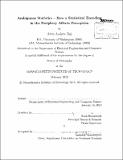Ambiguous statistics - how a statistical encoding in the periphery affects perception
Author(s)
Raj, Alvin Andrew
DownloadFull printable version (25.08Mb)
Alternative title
How a statistical encoding in the periphery affects perception
Other Contributors
Massachusetts Institute of Technology. Department of Electrical Engineering and Computer Science.
Advisor
Ruth Rosenholtz.
Terms of use
Metadata
Show full item recordAbstract
Recent understanding in human vision suggests that the periphery compresses visual information to a set of summary statistics. Some visual information is robust to this lossy compression, but others, like spatial location and phase are not perfectly represented, leading to ambiguous interpretations. Using the statistical encoding, we can visualize the information available in the periphery to gain intuitions about human performance in visual tasks, which have implications for user interface design, or more generally, whether the periphery encodes sufficient information to perform a task without additional eye movements. The periphery is most of the visual field. If it undergoes these losses of information, then our perception and ability to perform tasks efficiently are affected. We show that the statistical encoding explains human performance in classic visual search experiments. Based on the statistical understanding, we also propose a quantitative model that can estimate the average number of fixations humans would need to find a target in a search display. Further, we show that the ambiguities in the peripheral representation predict many aspects of some illusions. In particular, the model correctly predicts how polarity and width affects the Pinna-Gregory illusion. Visualizing the statistical representation of the illusion shows that many qualitative aspects of the illusion are captured by the statistical ambiguities. We also investigate a phenomena known as Object Substitution Masking (OSM), where the identity of an object is impaired when a sparse, non-overlapping, and temporally trailing mask surrounds that object. We find that different types of grouping of object and mask produce different levels of impairment. This contradicts a theory about OSM which predicts that grouping should always increase masking strength. We speculate some reasons for why the statistical model of the periphery may explain OSM.
Description
Thesis (Ph. D.)--Massachusetts Institute of Technology, Dept. of Electrical Engineering and Computer Science, 2013. Cataloged from PDF version of thesis. Includes bibliographical references (p. 159-163).
Date issued
2013Department
Massachusetts Institute of Technology. Department of Electrical Engineering and Computer SciencePublisher
Massachusetts Institute of Technology
Keywords
Electrical Engineering and Computer Science.